Pivoting on Service in the Cloud Forest
Blog: Week 1 of Service
Isa H.
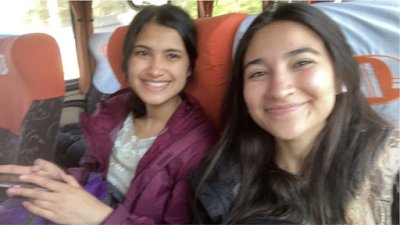
On our way to our service town in the Ecuadorian Cloud Forest, Lisa and I weren’t quite sure what to expect. With nervous stomachs and bladders, we sat on the bus for about 2 to 3 hours waiting patiently as there were various stops along the way. Both of us were filled with excitement to meet our host families as well as our new placements in the Municipality. Lisa would be working with the water quality and I would be working with the elderly at a community center. Lisa, an environmental science major and I, a social work major, were not quite ready for what would await us.
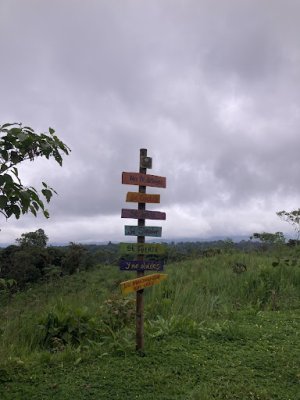
“Don’t stop, be constant, be happy, be a dreamer, be strong, and don’t forget how marvelous you are!”
The colorful sign placed at the entrance of Lisa’s host parent’s property has lingered on my mind from the moment I laid my eyes on it. As the daughter of past and present SST leaders, I knew exactly what kinds of challenges would be in store for me heading into service. Before I left Quito, I was determined to maintain a joyful mindset and a good attitude. However, I didn’t expect that mentality to be immediately challenged when I arrived at the Municipality for my first day of work. After greetings and small talk, I found out that my placement would be changed to working on water quality and trash management with Lisa. The elderly were on a break and would not be back until maybe sometime in March, that is if they even decided to change me back to that placement. While I have dealt with change often, I tried to hide my disappointment and my heart sank as I began my 8-5 workday in environmental work I knew nothing about.
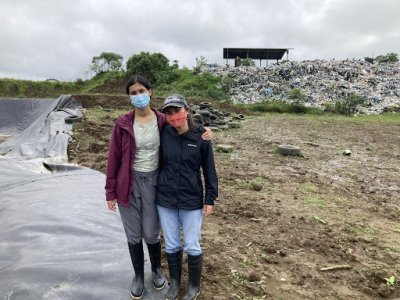
While we sat in the Municipality building for many hours most days, the highlight of my week was visiting the landfill. Lisa and I headed over in a truck, driving down windy roads until we arrived in a hidden area in the Cloud Forest that was completely full of trash. Alba, who is in charge of the trash and landfill for the Municipality, explained to us the grave problems they face. One was that their original landfill was beginning to overflow and become unusable.
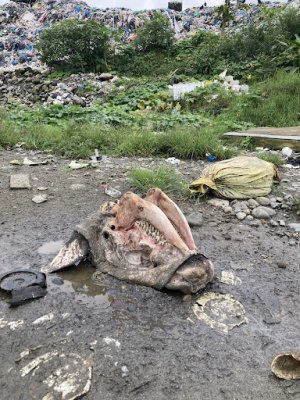
As someone who has never been to a landfill before (not even in the U.S.) I was not prepared for the intensity of smells or sights that would be scattered everywhere. When someone was on machinery moving trash, the smell made Lisa and I both gag as buzzards flew around our heads. The landfill is full of many types of trash, including from bathrooms as people here do not flush toilet paper and instead throw it in little trash cans. But perhaps what really struck me was encountering various rotting cow heads and bones. Above you can see I found one cow head that was being pecked at by buzzards as the skin is peeling off the bones from the humidity, rain, and heat. Here they have no funding to hire workers or any resources to properly cover the trash and flatten it, so instead, it piles up and is in the open air. The recyclers, a vulnerable population, also go to the landfill and dig through the trash to find recyclable materials, often without a mask or gloves.
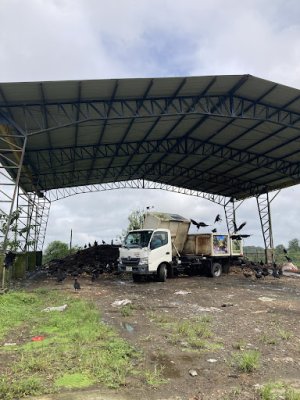
Lisa and I luckily had the opportunity to see how they deposit organic materials since the workers arrived during our time there. These men bring organic materials to a shelter right next to the landfill which used to have a system to process it into fertilizer. Now, other towns occasionally come and pick it up for use elsewhere, but it is often left sitting there to decompose. The buzzards, desperate and in masses, eat even the organic plant food scraps. Alba, normally quiet, cracked a joke that they’d become vegetarians.
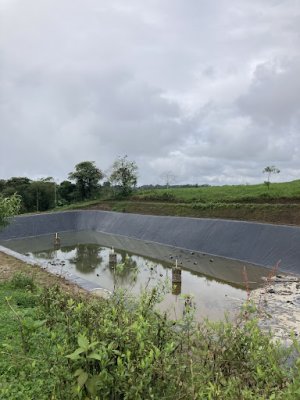
The new landfill they created currently has many flaws in its construction. For me, this was one of the most disheartening things to learn about. They spent 300,000 US dollars to make this new, yet unusable, structure. One big problem is that it is not built for the rainy and humid climate of the cloud forest. The rock structures in the middle are used to release methane gasses and the bottom of the bin has filters to take out the liquid that is produced from the trash. This structure is not supposed to be full of water, but because of frequent rains, mud has collected at the bottom which means the filters are not working properly. Recently, a side of the wall caved in from the rain due to them not using concrete in the original construction. Concrete here is extremely expensive and Alba said it would cost an additional 300,000 USD to fill one side of the landfill with concrete. When I started to calculate in my head the cost of reinforcing the entire structure I realized that it would be more than a million US dollars to add concrete and make it more secure. They also have yet to make a ramp for the trucks to go in and dump the trash. The damp ground worried me because as we stood on one side of the bin my boots were sinking into the dirt. How would it support a truck full of trash? My head was spinning trying to comprehend the gravity of the situation.
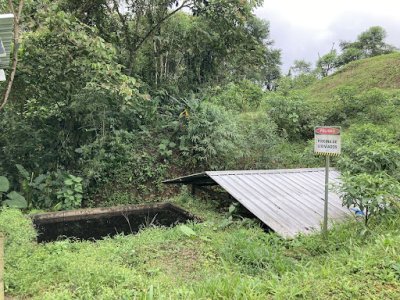
Above you can see a small pool of water with a sign that says “peligro piscina de lixiviados” and this is connected to water quality. Lixiviados means liquids that are accumulated from the trash and go through pipes to different plants for purification. Currently, almost none of these systems are functioning. The filters don’t work well and the rain carries much of the lixiviados straight to the rivers. Generally, after the cleaning process, they dump the water back into the rivers. But since they haven’t been able to clean the liquids well, they constantly are putting contaminated water into the rivers and environment. This is a huge problem. Waterfalls and rivers are becoming increasingly contaminated by trash, unclean water, and industrial wastes. This not only affects nature but also the people who live downstream.
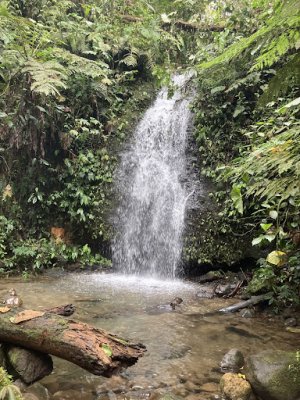
(Waterfall from Lisa’s host parent’s property)
This week was full of challenges and changes. I became a translator, a listener, and much more of an environmentalist. Given I don’t know much about environmental sciences or water/trash treatment, I was battling with really understanding what was happening most of the time but luckily Lisa and I make a good team. Before this, I was not the most environmentally conscious person and now I have recognized how much we need to take care of our environment. So while my placement has changed to something vastly different, I am grateful for this opportunity to learn more about the problems people are facing and spend time in this beautiful town. Now when I feel down or frustrated I repeat to myself: “Don’t stop, be constant, be happy, be a dreamer, be strong, and don’t forget how marvelous you are!”




